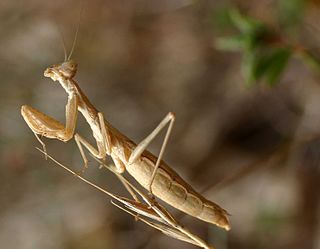 W
WPerlamantis is a genus of praying mantids in the family Amorphoscelidae. Species records are from Northern Africa and the Iberian peninsula.
 W
WAmeles is a wide-ranging genus of praying mantises represented in Africa, Asia, and Europe.
 W
WAmeles decolor is a species of praying mantis native to the west Mediterranean.
 W
WAmeles heldreichi is a species of praying mantis that lives in France, Italy, Spain, Macedonia, Croatia, Greece, Israel, Libya, Palestine, Turkey, Romania, Ukraine, Russia and Cyprus. Type locality is Putini (Croatia).
 W
WAmeles spallanzania, common name European dwarf mantis, is a species of praying mantis.
 W
WApteromantis aptera is a species of praying mantis endemic to the Iberian Peninsula. It was first described by José María Hugo de la Fuente Morales in 1894. It was previously considered to be endangered by the IUCN, but has been downgraded to least concern, as the populations are rising and they are spreading to new habitats in south-central Spain and southern Portugal.
 W
WEmpusa fasciata is a species of praying mantis in the genus Empusa in the order Mantodea.
 W
WEmpusa pennata, or the conehead mantis, is a species of praying mantis in genus Empusa native to the Mediterranean Region. It can be found in Portugal, Spain, southern France, Italy and on the mediterranean coasts of Morocco, Algeria, Tunisia, Libya and Egypt. Because of its fragmented, low density populations, it is very rarely found in nature.
 W
WThe European mantis is a large hemimetabolic insect in the family of the Mantidae ('mantids'), which is the largest family of the order Mantodea (mantises). Their common name praying mantis is derived from the distinctive posture of the first pair of legs that can be observed in animals in repose. It resembles a praying attitude. Both males and females have elongated bodies with two pairs of wings. The most striking features that all Mantodea share are a very mobile, triangular head with large compound eyes and their first pair of legs, which is highly modified for the efficient capture and restraint of fast-moving or flying prey.
 W
WIris oratoria, known by the common name Mediterranean mantis or iris mantis, is a widespread species of praying mantis native to Europe. It is found as an introduced species in the Middle East, Western Asia and the United States. Iris oratoria invaded southern California in the 1930s and seems to be spreading.
 W
WOligonicella is a wide-ranging genus of mantises in the family Thespidae. It is represented in Africa, Asia, Europe, and North America.
 W
WPhyllocrania paradoxa, common name ghost mantis, is a small species of mantis from Africa remarkable for its leaf-like body. It is one of the three species in the genus Phyllocrania. It is known for its distinct and exclusive camouflaged appearance of a dry weathered leaf.
 W
WThe Rivetinidae are a family of praying mantids, based on the type genus Rivetina. As part of a major revision of mantid taxonomy, this family contains many genera moved from Miomantinae: tribe Rivetinini; some genera previously placed there have now been moved to the new families Deroplatyidae and Chroicopteridae. The new placement of this taxon is in the superfamily Eremiaphiloidea and infraorder Schizomantodea.